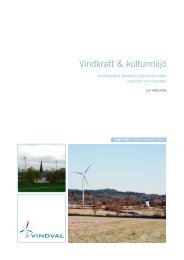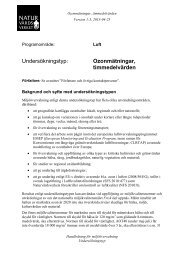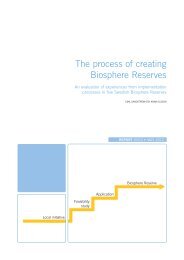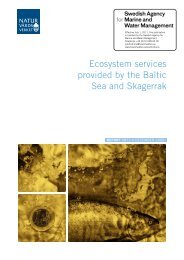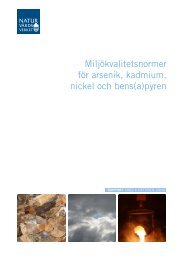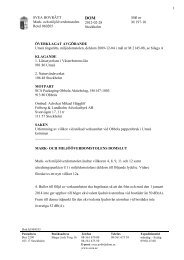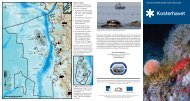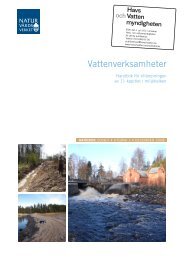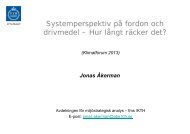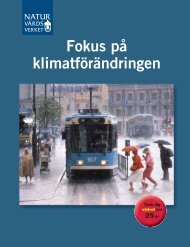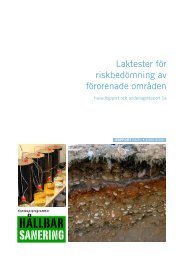Kombinationseffekter av föroreningar (pdf 385 kB) - Naturvårdsverket
Kombinationseffekter av föroreningar (pdf 385 kB) - Naturvårdsverket
Kombinationseffekter av föroreningar (pdf 385 kB) - Naturvårdsverket
Create successful ePaper yourself
Turn your PDF publications into a flip-book with our unique Google optimized e-Paper software.
English summary<br />
SWECO VIAK<br />
<strong>Kombinationseffekter</strong> <strong>av</strong> <strong>föroreningar</strong><br />
This report addresses the challenges associated with the calculation of the toxicity of<br />
mixtures of chemicals and the estimation of environmental and health risks of those mixtures.<br />
It is obvious that practical limitations precludes toxicity testing of all possible combinations of<br />
chemicals and concentrations – for instance, testing the toxicity of all combinations of only 10<br />
individual chemicals would require at least 1000 separate assays. As an alternative, the<br />
evaluation of mixture toxicity and risk is based on mathematical and statistical modelling.<br />
The reader is introduced to the most common models to classify and calculate mixture<br />
toxicity. Included are models assuming that 1) the chemicals act independently of each other<br />
in the organisms; 2) the chemicals h<strong>av</strong>e the same mechanism of toxicity, affect the same<br />
endpoint, or h<strong>av</strong>e the same chemical structure; 3) the chemicals interact with each other in<br />
synergistic or antagonistic ways. Physiologically based pharmacokinetic (PBPK) models<br />
describing metabolism and toxicity of mixtures are briefly presented, and new approaches to<br />
use quantitative structure-activity relationships (QSAR) to estimate toxicity of mixtures from<br />
predicted chemical characteristics of the mixtures are reviewed. Reviews of the scientific<br />
literature shows that the toxicity of 75-80 % of known mixtures of two to four chemicals can<br />
be safely calculated by concentration addition, which means that the contribution of each<br />
component to the mixture toxicity is proportional to its concentration in the mixture.<br />
Schematic decision trees are constructed in the report to help the assessor to evaluate the<br />
toxicity and risk of complex mixtures of more or less unknown composition. Whole mixture<br />
toxicity test at different concentrations is the simplest approach, although sometimes<br />
cumbersome if one or several components are very toxic. Mixtures can be fractionated<br />
based on successive bioassays, fractionated and recombined, fractionated in combination<br />
with identification and toxicity testing of the 10 most risky components, and chemically<br />
identified in combination with a multivariate effects analysis. Since the number of complex<br />
mixtures in the environment is just formidable, the report reviews efforts to develop criteria to<br />
prioritise among them and presents list of prioritised mixtures containing similar components,<br />
mixtures of known and predictable composition, and mixtures of occasional composition or<br />
appearance.<br />
The environmental and health risk of mixtures is often expressed by an index by which the<br />
exposure to an individual component is compared to a guideline or regulatory value of the<br />
8



